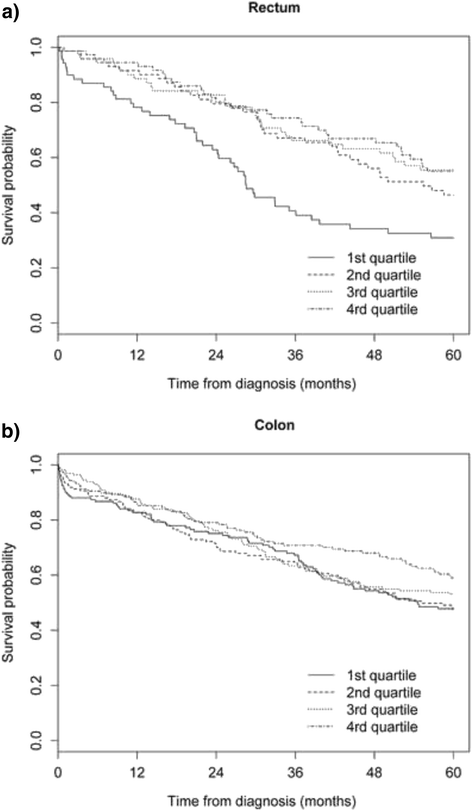Effect of diagnostic delay on survival in patients with colorectal cancer: a retrospective cohort study
- PMID: 27549406
- PMCID: PMC4994409
- DOI: 10.1186/s12885-016-2717-z
Effect of diagnostic delay on survival in patients with colorectal cancer: a retrospective cohort study
Abstract
Background: Disparate and contradictory results make studies necessary to investigate in more depth the relationship between diagnostic delay and survival in colorectal cancer (CRC) patients. The aim of this study is to analyse the relationship between the interval from first symptom to diagnosis (SDI) and survival in CRC.
Methods: Retrospective study of n = 942 CRC patients. SDI was calculated as the time from the diagnosis of cancer and the first symptoms of CRC. Cox regression was used to estimate five-year mortality hazard ratios as a function of SDI, adjusting for age and gender. SDI was modelled according to SDI quartiles and as a continuous variable using penalized splines.
Results: Median SDI was 3.4 months. SDI was not associated with stage at diagnosis (Stage I = 3.6 months, Stage II-III = 3.4, Stage IV = 3.2; p = 0.728). Shorter SDIs corresponded to patients with abdominal pain (2.8 months), and longer SDIs to patients with muchorrhage (5.2 months) and rectal tenesmus (4.4 months). Adjusting for age and gender, in rectum cancers, patients within the first SDI quartile had lower survival (p = 0.003), while in colon cancer no significant differences were found (p = 0.282). These results do not change after adjusting for TNM stage. The splines regression analysis revealed that, for rectum cancer, 5-year mortality progressively increases for SDIs lower than the median (3.7 months) and decreases as the delay increases until approximately 8 months. In colon cancer, no significant relationship was found between SDI and survival.
Conclusions: Short diagnostic intervals are significantly associated with higher mortality in rectal but not in colon cancers, even though a borderline significant effect is also observed in colon cancer. Longer diagnostic intervals seemed not to be associated with poorer survival. Other factors than diagnostic delay should be taken into account to explain this "waiting-time paradox".
Keywords: Colorectal neoplasms; Delayed diagnosis; Mortality; Nonparametric; Statistics; Survival.
Figures


References
-
- International Agency for Research on Cancer . GLOBOCAN 2012: estimated cancer incidence, mortality and prevalence worldwide in 2012. Lyon: IARC; 2013.
-
- López-Abente G, Ardanaz E, Torrella-Ramos A, Mateos A, Delgado-Sanz C, Chirlaque MD, et al. Changes in colorectal cancer incidence and mortality trends in Spain. Ann Oncol. 2010;21 Suppl 3:iii76–82. - PubMed
Publication types
MeSH terms
LinkOut - more resources
Full Text Sources
Other Literature Sources
Medical

